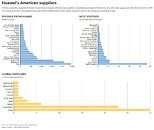- Joined
- Oct 9, 2007
- Messages
- 47,293 (7.53/day)
- Location
- Hyderabad, India
| System Name | RBMK-1000 |
|---|---|
| Processor | AMD Ryzen 7 5700G |
| Motherboard | ASUS ROG Strix B450-E Gaming |
| Cooling | DeepCool Gammax L240 V2 |
| Memory | 2x 8GB G.Skill Sniper X |
| Video Card(s) | Palit GeForce RTX 2080 SUPER GameRock |
| Storage | Western Digital Black NVMe 512GB |
| Display(s) | BenQ 1440p 60 Hz 27-inch |
| Case | Corsair Carbide 100R |
| Audio Device(s) | ASUS SupremeFX S1220A |
| Power Supply | Cooler Master MWE Gold 650W |
| Mouse | ASUS ROG Strix Impact |
| Keyboard | Gamdias Hermes E2 |
| Software | Windows 11 Pro |
The trade ban imposed on Chinese tech giant Huawei by the U.S. Department of Commerce, and ratified through an Executive Order by President Donald Trump, is cutting both ways. Not only are U.S. entities banned from importing products and services from Huawei, but also engaging in trade with them (i.e. selling to them). U.S. tech firms stare at a $11 billion revenue loss by early estimates. Wall Street firm Goldman Sachs compiled a list of companies impacted by the ban, and the extent of their revenue loss. It turns out that AMD isn't a small player, and in fact, stands to lose more revenue in absolute terms than even Microsoft. It earns RMB 268 million (USD $38.79 million) from Huawei, compared to Microsoft's RMB 198 million ($28.66 million). Intel's revenue loss is a little over double that of AMD at RMB 589 million ($84 million), despite its market-share dominance.
That's not all, AMD's exposure is higher than that of Intel, since sales to Huawei make up a greater percentage of AMD's revenues than it does Intel's. AMD exports not just client-segment products such as Ryzen processors and Radeon graphics, but possibly also EPYC enterprise processors for Huawei's server and SMB product businesses. NVIDIA is affected to a far lesser extent than Intel, AMD, and Microsoft. Qualcomm-Broadcom take the biggest hit in absolute revenue terms at RMB 3.5 billion ($508 million), even if their exposure isn't the highest. The duo export SoCs and cellular modems to Huawei, both as bare-metal and licenses. Storage hardware makers aren't far behind, with the likes of Micron, Seagate, and Western Digital taking big hits. Micron exports DRAM and SSDs, while Seagate and WDC export hard drives.

View at TechPowerUp Main Site
That's not all, AMD's exposure is higher than that of Intel, since sales to Huawei make up a greater percentage of AMD's revenues than it does Intel's. AMD exports not just client-segment products such as Ryzen processors and Radeon graphics, but possibly also EPYC enterprise processors for Huawei's server and SMB product businesses. NVIDIA is affected to a far lesser extent than Intel, AMD, and Microsoft. Qualcomm-Broadcom take the biggest hit in absolute revenue terms at RMB 3.5 billion ($508 million), even if their exposure isn't the highest. The duo export SoCs and cellular modems to Huawei, both as bare-metal and licenses. Storage hardware makers aren't far behind, with the likes of Micron, Seagate, and Western Digital taking big hits. Micron exports DRAM and SSDs, while Seagate and WDC export hard drives.

View at TechPowerUp Main Site







